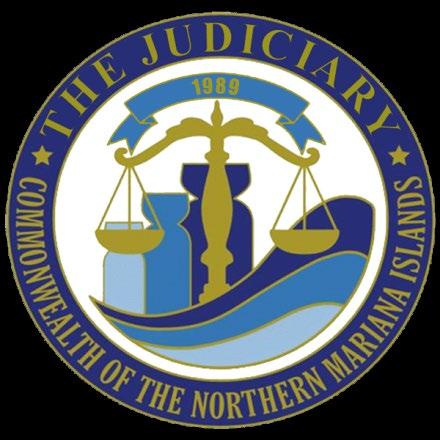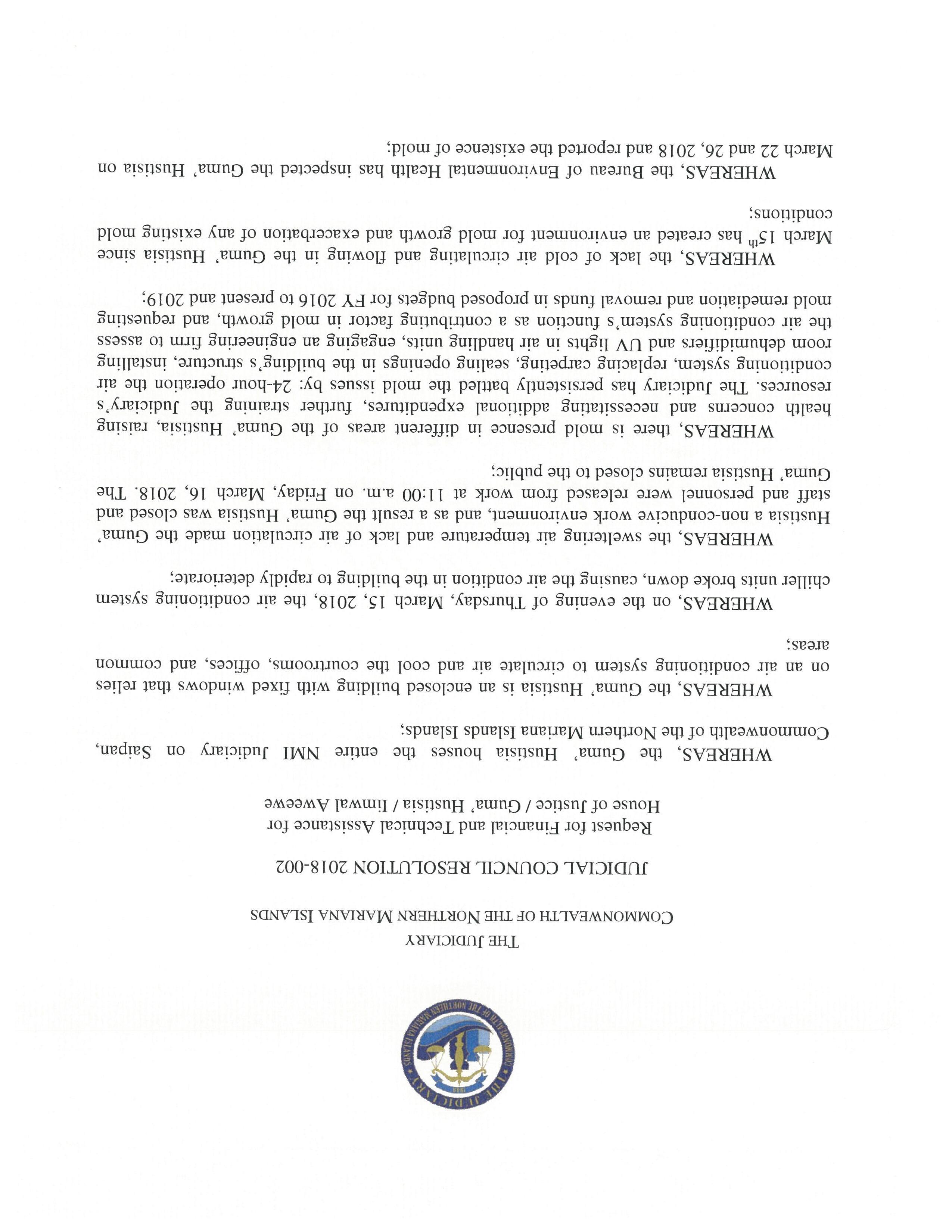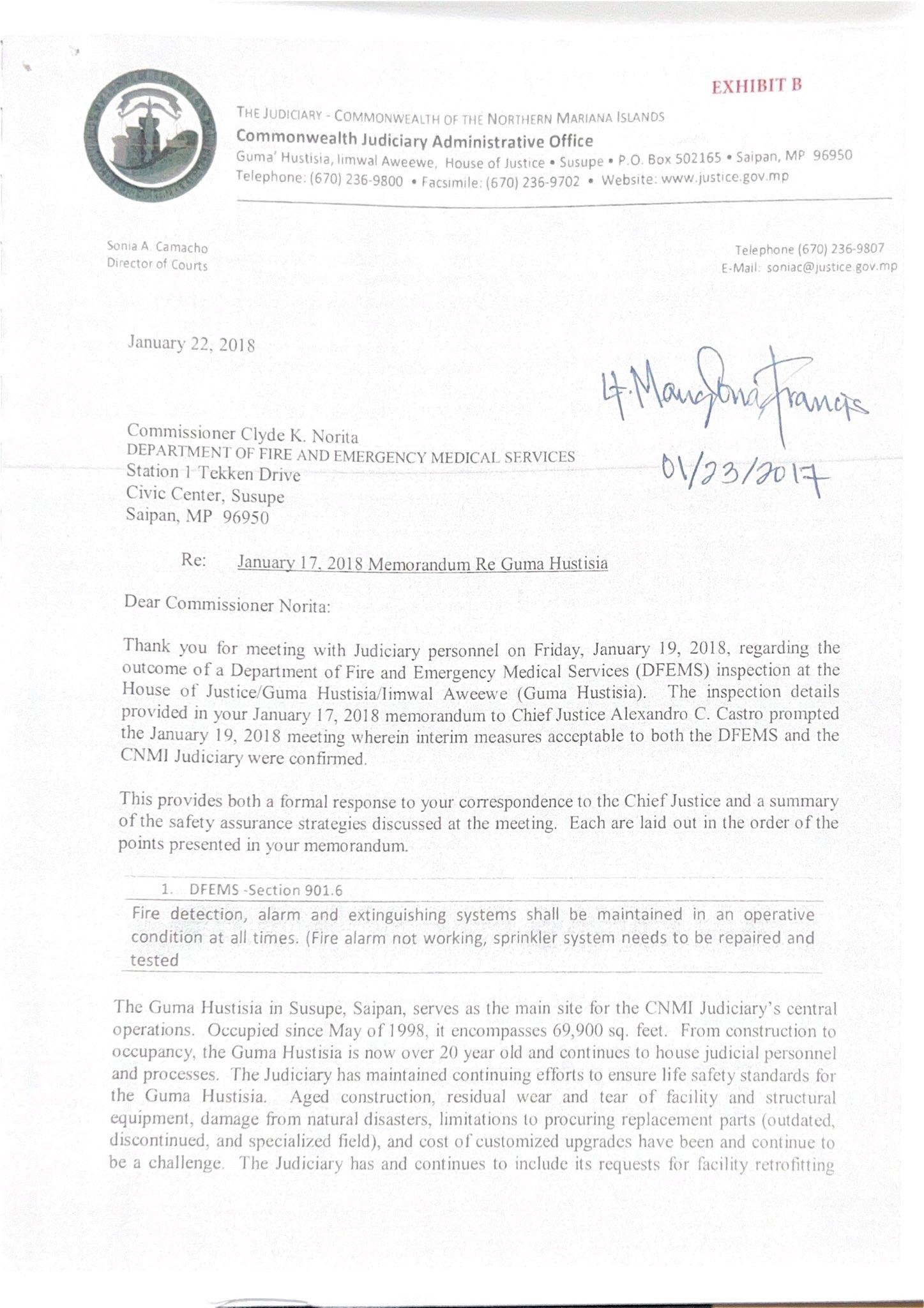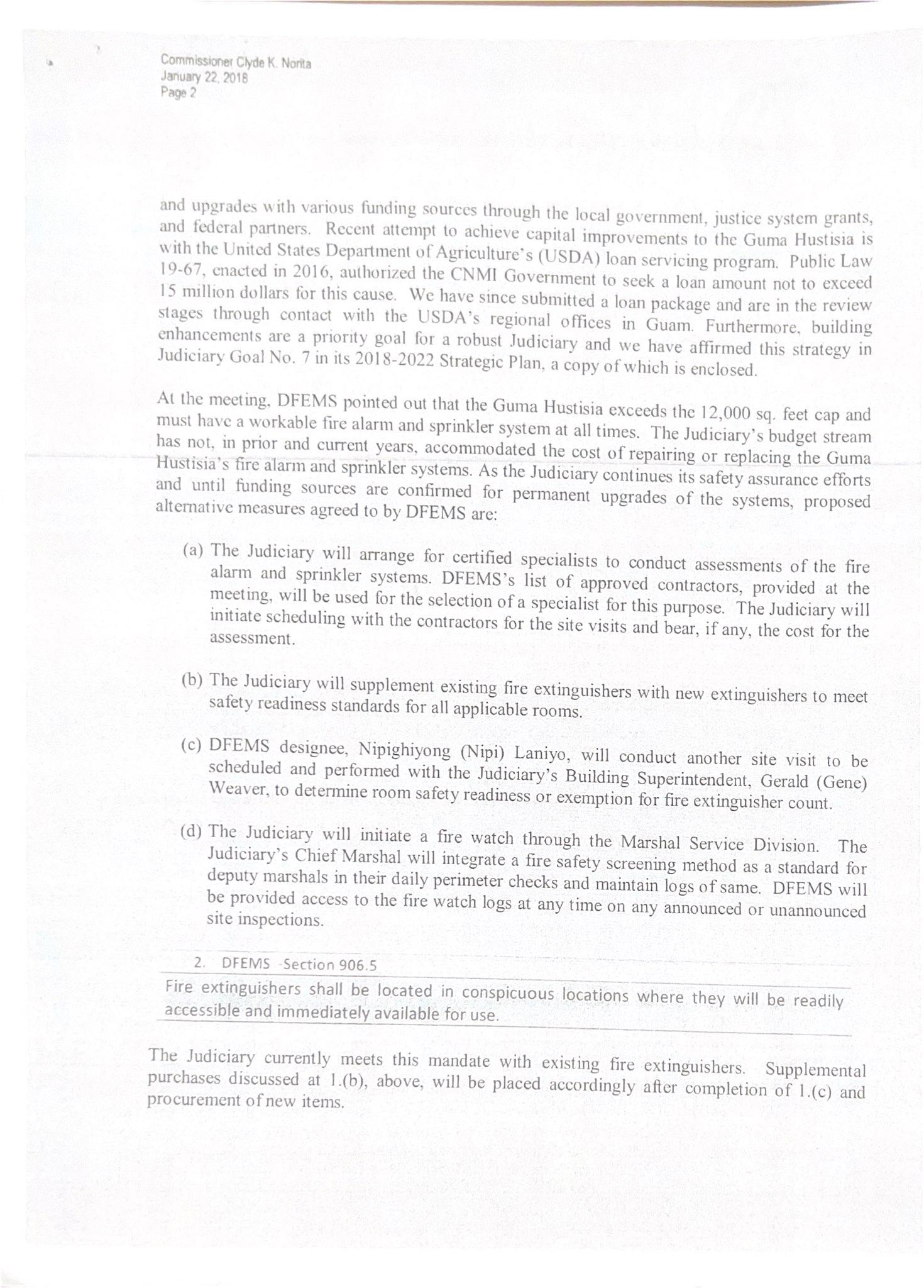
7 minute read
Exhibit E Report No. 2
Commonwealth Judiciary Administrative Office
Guma’ Hustisia, IimwalAweewe, House of Justice •Susupe• P.O. Box 502165 • Saipan, MP 96950
Advertisement
Telephone: (670) 236-9800 • Facsimile: (670) 236-9702 • Website: www.justice.gov.mp
Guma’ Hustisia
Air Conditioning and Mold Removal and Remediation Project Report No. 2 – March 29, 2018
A. Overview
On Thursday, March 22, the Judiciary released its First Preliminary Report on the Guma’ Hustisia Air Conditioning and Mold Removal and Remediation Project. In the March 22 Preliminary Report, we provided background on the air conditioning and mold issues plaguing the Guma’ Hustisia. We also detailed the steps the Judiciary has taken to manage the building’s closure since the air conditioning shutdown on Friday, March 16, as well as outlining our shortand long-term goals for managing the Judiciary’s operations and restoring the Guma’ Hustisia. Please refer to the March 22 Preliminary Report for such information.
In this Report, we detail our progress over the previous week and justify each of our objectives. We hope this correspondence will assist the Executive and Legislative branches in providing immediate financial and technical assistance for the assessment and remediation of mold and procurement of an air conditioning system.
The Project estimate now totals $7 million 1:
• Air-conditioning system: $4.4 million
• Mold removal and remediation, including collateral expenses: $2.6 million
B. Current Status: March 22–March 29
Since the March 22 Preliminary Report, we continued gathering information on the mold and airconditioning issues and providing court proceedings and services at alternate locations, including the U.S. District Court in Garapan, Department of Public Safety offices, Pedro P. Tenorio Multipurpose Center, and the RSAT building in Susupe.
1. The Judiciary has disseminated information and set up channels for ensuring communication while divisions are segmented.
1.1 Following the Judiciary leadership team’s meeting with Governor Ralph DLG Torres on March 22, the members of the bench met to discuss new developments.
1.2 On March 26, the Judiciary held a general assembly, briefing employees on the Judiciary’s current state and opening the floor for questions, comments and suggestions.
1 This figure has increased from the $5 million estimate provided in the March 22 Preliminary Report as the Judiciary has gathered further information.
1.3 Since March 26, the Judiciary’s managers have met daily to facilitate spread of information between divisions.
1.4 On March 28, Judicial Council members met with Speaker Rafael S. Demapan and President Arnold S. Palacios to discuss the Guma’ Hustisia’s status.
1.5 On March 29, the Judiciary met with the CNMI Bar Association to update the bar on the ongoing status of the Guma’ Hustisia.
1.6 On March 29, the Judicial Council adopted a resolution requesting the Executive and Legislative branches for financial and technical assistance in the amount of $7 million.
2. We have continued our mold remediation efforts.
2.1 On March 26, BEH conducted a second assessment of the building and reported the existence of mold.
2.2 Carpeting has been removed in multiple locations and unnecessary books and papers are being relocated.
2.3 Masks have been made available to employees entering the building.
2.4 Industrial hygienists capable of providing mold remediation assessment services have been identified on island.
2.5 Plans to prevent future mold growth are also being developed.
3. Planning for air-conditioning replacement is also occurring.
3.1 The partially-functioning chiller continues to be operated, but may breakdown at any time The unit is running below optimal design specifications, operating on a manual switch that must be monitored daily for proper pressurization and other mechanical operation. The unit is incapable of providing the appropriate cooling temperature in the building. The backup units remain inoperable
3.2 Stand-up air-conditioning units are in the process of being procured before the remaining chiller ceases to function.
4. We continue to explore satellite offices for court services while attempting to address challenges that have arisen due to the Judiciary’s segmented operations.
4.1 Marshals are stretched thin monitoring multiple locations while serving arrest warrants and providing bench protection.
4.2 Members of the public are forced to wait outside buildings in long lines to access many of the Judiciary’s services.
4.3 Operations are stymied while employees without laptops or remote access to documents wait for assistance.
In summary, divisions are stretched thin and prolonged satellite operations may cause certain Judiciary services to cease operation. Further mold removal and remediation plans require additional funding and expedited procurement. As with mold removal and remediation, further steps regarding system-wide replacement of our air-conditioning system require additional funding and expedited procurement.
C. Objectives
The Judiciary’s short-term and long-term goals allow restoration of the Guma’ Hustisia’s safety while facilitating operation of the judicial branch in the interim. Below, we detail our objectives and provide justifications. Updated funding figures will be provided in later reports.
1. Short-Term Goals
a. Monitor and Manually Operate the Remaining Partially-Functioning Chiller
i. While two of the Guma’ Hustisia’s three chillers are now completely inoperable, one chiller was brought partially on-line on Wednesday, March 21.
ii. Because the unit’s control board is nonresponsive, it is running on a manual switch. Manual operation of the chiller requires daily maintenance bythe building maintenance manager and an airconditioning specialist. The chiller may breakdown at any time because of its advanced age, deteriorating condition, and recent bypass repair. Additionally, it is only partially operating: the chiller has only been able to produce 50-55-degree water, as opposed to its ideal temperature of 45-47 degrees.
iii. Although the chiller is insufficient for long-term operation, it should continue to run while the air conditioning system is replaced and moldremediation is done. This will slow mold growth and provide airflow for employees tasked with cleaning the building.
b. Receive and Analyze Results of BEH Mold Assessment
i. The Bureau of Environmental Health conducted an initial assessment of the Guma’ Hustisia on Wednesday, March 22. BEH conducted a follow-up mold assessment on Monday, March 26. Receipt of BEH’s report will allow the Judiciary to further assess the extent of mold remediation efforts needed.
c. Hire Industrial Hygienist to Review and Evaluate Potentially Problematic Environmental Factors and Facilitate Proper Cleaning
i. An industrial hygienist tests workplace environmental hazards, determines if they pose a health risk, and recommends means of controlling or eradicating the health hazard. An industrial hygienist is needed to examine the presence of mold in the Guma’ Hustisia. The hygienist’s help is needed to assess where the mold is located, how to properly remove the mold, what type of mold is present, and other related concerns.
ii. Mold removal and remediation efforts may not properly begin until an industrial hygienist has made an assessment.
iii. Two industrial hygienists have preliminarily assessed the Guma’ Hustisia and an additional hygienist will soon perform another initial review. However, without procurement processes in place the Judiciary is unable to proceed further with obtaining a hygienist.
d. Remove Furniture, Carpeting, and Materials that Exacerbate Mold Growth
i. As discussed in the FY 2019 Budget Request, the Office of the Governor’s Capital Improvement Project (CIP) provided funding and oversight for the hiring of an engineering firm to assess the building’s mold issue.
ii. The engineering firm recommended we remove all carpet, furniture, books, paper, clothing, and sagging ceiling tiles infested by mold.
iii. The Judiciary intends to heed this recommendation and not only remove items affected by mold, but also remove items that have the potential to exacerbate mold growth. This includes removal of furniture, books, and paper from offices. It also includes removing and replacing carpeting. Such steps will require additional assistance from employees and procurement of a company to replace flooring.
e. Procure Services of an Industrial Hygienist and Other Professionals to Remove Mold
i. Once an industrial hygienist assesses the Guma’ Hustisia, we will follow any cleaning recommendations provided These recommendations may include professionally cleaning furniture, walls, air vents, and other areas.
ii. Such cleaning services are beyond the scope of the Judiciary’s current janitorial services and will require procurement of an outside company, necessitating additional funding.
f. Procure Stand-Up Air-Conditioning Units for Peripheral Offices
i. Stand-up air-conditioning units will allow air circulation and prevent mold growth while a permanent air-conditioning system is installed ii. Because the stand-up units require drainage, they may only be placed in peripheral offices. As such, these units are insufficient to function as a long-term air-conditioning system for the Guma’ Hustisia. However, these units will allow the Judiciary to return its operations to the Guma’ Hustisia more quickly. iii. Governor Ralph DLG Torres has kindly promised to provide funding for the stand-up air conditioning units.
g. Secure Funding for Drug Court and Information Technology Satellite Office
i. The Judiciary had been pursuing alternative sources of funding to establish a satellite office for Drug Court on Capitol Hill, applying for a SNILD grant as recently as February 6, 2018. The satellite office was requested in order to secure storage of back-up court information and provide emergency court services during and after emergencies.
ii. Given the shutdown of the Guma’ Hustisia, Drug Court proceedings have been moved to an alternative site. Currently, Drug Court and Family Court proceedings are operating in the same hallway, resulting in the overlap of proceedings that each raise confidentiality concerns.
iii. Due to these unforeseen circumstances, the grant request must be set aside in lieu of a faster solution. The Judiciary requests the Legislature’s financial assistance in establishing the Drug Court satellite office in house units 1361 and 1362.
2. Long-Term Goals
a. Install New Air-Conditioning System i. Because two of the air-conditioning system’s chillers are in disrepair and one chiller is barely functioning, restoration of Judiciary operations in the Guma’ Hustisia will require the installation of a new air-conditioning system. According to the engineering firm’s recommendations, this overhaul includes replacing air handling units, water pumps, and remote air-cooled condensers, amongst other components. Because these units must be designed specifically for the Guma’ Hustisia, their manufacture and shipment will require several months. b. Complete Clean-Up and Mold Removal i. Mold is a serious concern for the people of the Commonwealth, and as a completely sealed building, the Guma’ Hustisia requires continuous monitoring. Ongoing mold removal and remediation efforts will be required in order to provide a safe environment for court staff and the public. ii. Each clean-up and mold removal session will involve hiring an outside company, necessitating additional funds.
D. Conclusion
The Judiciary continues operating critical services from satellite locations while developing and implementing short and long-term plans to restore the Guma’ Hustisia.
The air-conditioning system shutdown exacerbated mold growth throughout the building. The partially-operating chiller is only mitigating the growth of mold; once this chiller breaks down, mold growth may damage the building beyond repair. Delayed action will further exacerbate the spread of mold throughout the Guma’ Hustisia, resulting in increased costs, delays, and health concerns. It is imperative that immediate action be taken stop the spread of the mold and investigate the degree of mold damage done to the building.
The initial cost estimates for both the short-term and long-term objectives may well exceed current estimates.


Exhibit G DFEMS Memorandum re: Failed Fire Code Inspection of Guma' Hustisia












